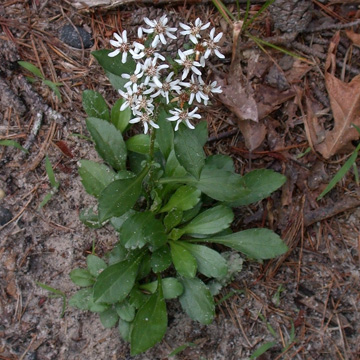

Sericocarpus asteroides - (image 1 of 4)
Taxonomy
Family: Asteraceae
Synonymous with Aster paternus
Habitat
Dry woods, in sandy, rocky, or clay soil.
Associates
Distribution
ME and VT to GA, west to southern OH, WV, eastern KY, eastern TN, and eastern AL.
Morphology
Perennial from a branched caudex; stems 15-60 cm, scabrous-puberulent in the inflorescence; leaves ciliate-margined and sometimes hairy as well, at least some evidently toothed; basal and lower cauline leaves usually enlarged and persistent, broadly oblanceolate to obovate, elliptic, or subrotund, petiolate; cauline leaves becoming sessile upwards, scarcely to strongly reduced; inflorescence corymbiform, flat-topped, heads in small glomerules; involucres glabrous, narrow, 5-9 mm; involucral bracts imbricate, broad, at least the outer ones with short spreading green tips; rays 4-8, white to pink, 4-8 mm; disk flowers 9-20, 4-5.5 mm, white or yellowish, seldom lavender; pappus bristles usually reddish, obscurely clavellate above.
Notes
Flowers July to August
Wetland indicator: NA
There are only five species in the strictly North American genus Sericocarpus, three of which occur in the eastern U.S. Sericocarpus linifolius occurs as far north as New Hampshire but is more common in the south and S. torifolius is only found along the coastal plain as far north as North Carolina.
References
Gleason, Henry A. and A. Cronquist. 1991. Manual of Vascular Plants of
Northeastern United States
and Adjacent Canada. Second Ed.
The New York Botanical Garden. Bronx, NY
|
Michael Hough © 2018 |